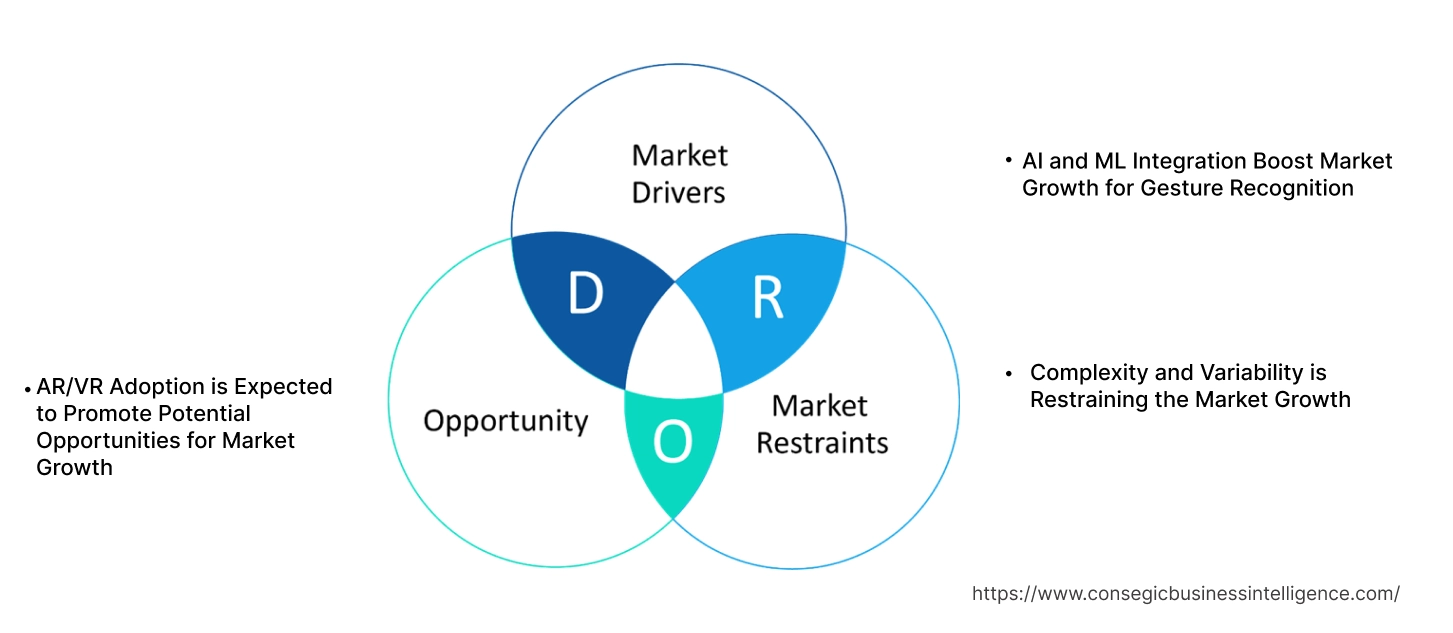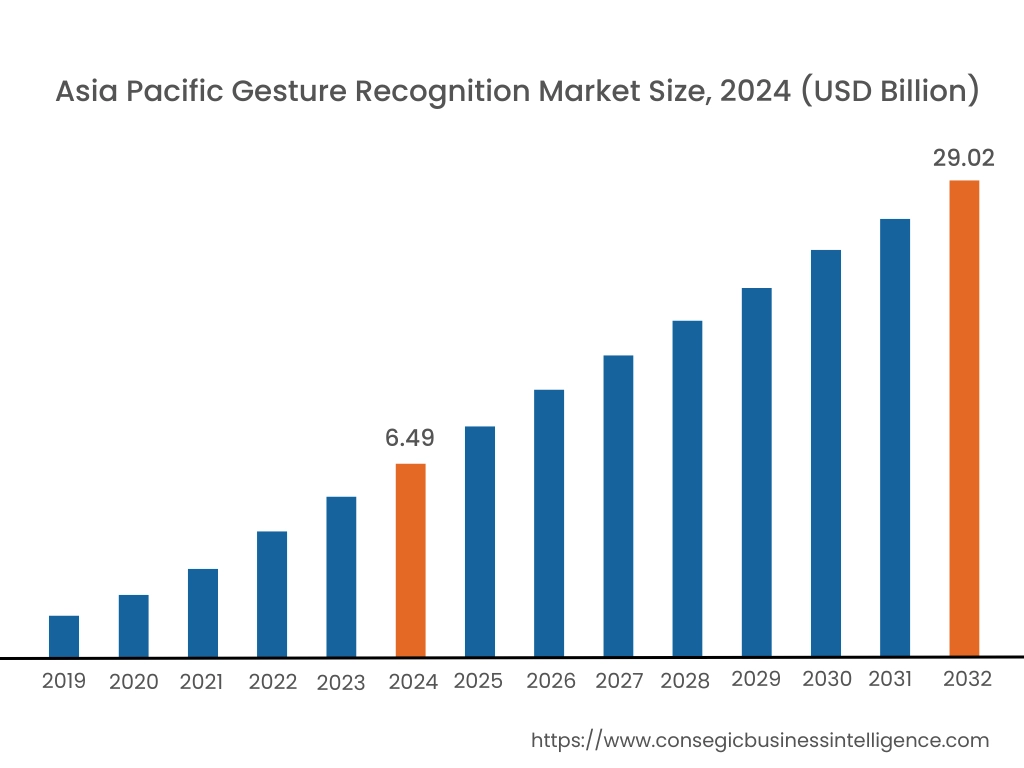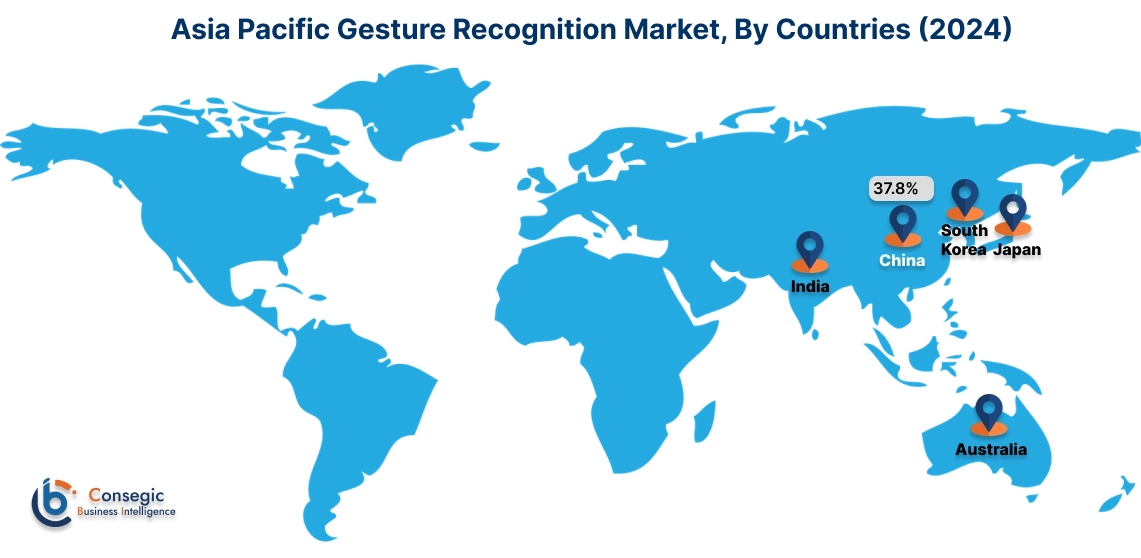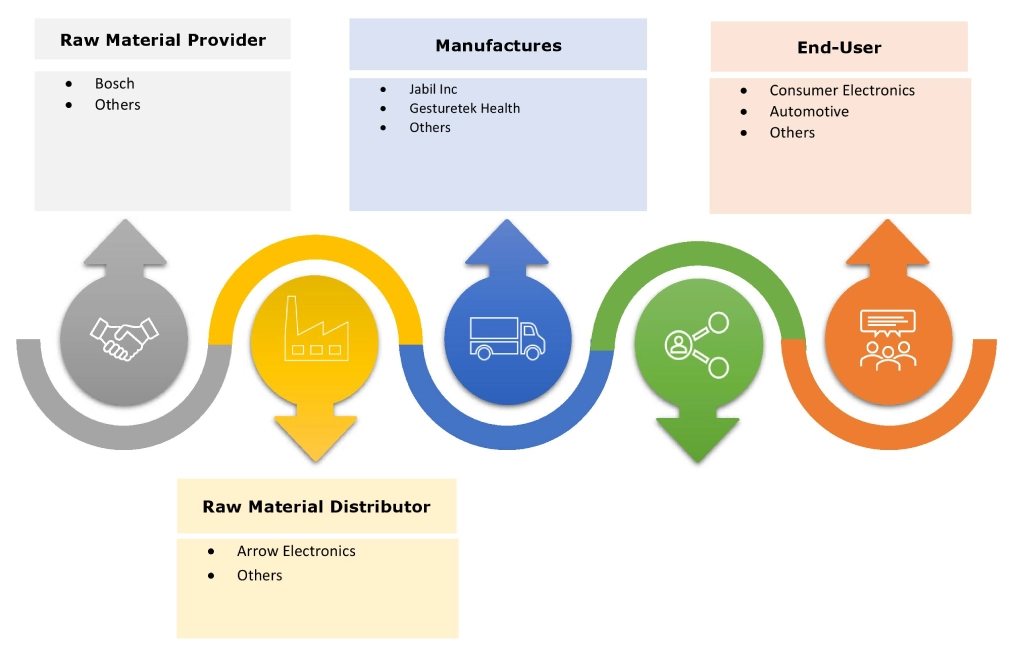Gesture Recognition Market Size:
Gesture Recognition Market is estimated to reach over USD 107.03 Billion by 2032 from a value of USD 24.63 Billion in 2024 and is projected to grow by USD 29.17 Billion in 2025, growing at a CAGR of 23.2% from 2025 to 2032
Gesture Recognition Market Scope & Overview:
Gesture recognition is technology that uses sensors to recognize and interpret human gestures by using mathematical algorithms. Additionally, sensors, cameras, or infrared systems capture real-time hand or body movements, and advanced algorithms analyze the data to identify specific gestures, in the end device performs the action, such as scrolling, zooming, and others. Moreover, the key advantages include good accuracy, robustness, and real-time implementation which in turn drives the gesture recognition market growth. The technology is majorly used in end use industries such as consumer electronics, gaming and entertainment, healthcare and others. Further, measures to protect health have become more evident which in turn is driving the gesture recognition market demand in medical facilities, hospitals, schools, hotels and others.
How is AI Impacting the Gesture Recognition Market?
AI is significantly impacting the gesture recognition market by enhancing accuracy, responsiveness, and functionality, leading to more intuitive and natural user interfaces. AI algorithms, particularly deep learning, enable systems to recognize complex gestures, adapt to user behavior, and improve over time. This has accelerated adoption across various sectors such as consumer electronics, automotive, and healthcare. Additionally, AI enables the recognition of complex gestures, facial expressions, and subtle movements, leading to more intuitive and immersive user experiences. Further, the increasing demand for intuitive and touchless interfaces, combined with advancements in AI and sensor technologies, is driving the growth of the gesture recognition market.
Gesture Recognition Market Dynamics - (DRO) :

Key Drivers:
AI and ML Integration Boost Market Growth for Gesture Recognition
AI and ML integrated gesture recognition enables systems to understand and interpret human gestures, enhancing interaction naturally and intuitively. The system features a combination of cameras and sensors together with machine learning systems. Additionally, machine learning algorithms allows systems to recognize hand and finger positions. Moreover, the features of AI based system include real time gesture detection, higher accuracy, robustness, customization and adaptability among others which in turn drives the gesture recognition market growth.
- For instance, in June 2021, Motion Gestures raised USD 2 million in pre-series A financing led by CCAA. The aim of funding is to leverage advances in artificial intelligence and machine learning to increases hand tracking and gesture recognition accuracy to nearly 100%.
Hence, the aforementioned key features of AI based system are driving the gesture recognition market demand.
Key Restraints:
Complexity and Variability is Restraining the Market Growth
Human gestures are incredibly diverse and recognizing complex gestures involving multiple joints and fine movements of hand as different users perform gestures differently, and the system must be robust enough to handle variability which in turn hinders the gesture recognition market expansion. Also, real time processing is crucial in applications such as gaming and AR/VR devices which in turn hinders the gesture recognition market expansion. Moreover, the accuracy is dependent on various factors such as lighting conditions, backgrounds, and user positions among others which is restraining the market development.
Therefore, the complexity and variability in motion recognition is restraining the market growth.
Future Opportunities :
AR/VR Adoption is Expected to Promote Potential Opportunities for Market Growth
AR and VR devices utilize motion recognition to enhance user experience and promote a more direct and natural interaction. The system employs sensors to collect data from users and machine leaning algorithms to interpret and respond to human activities in AR and VR devices which in turn is driving the gesture recognition market opportunities. Moreover, integrated AR and VR devices with hand movement recognition have capabilities such as moving or rotating objects, interacting with AR set of choices, and navigating AR environments is propelling the gesture recognition market opportunities.
- For instance, in June 2023, WiMi Hologram Cloud Inc, which is a leading AR technology provider launched virtual interaction system based on motion recognition. The system has the ability to recognizes user's body and gesture movements through a recognition device. Additionally, the key features include realistic visualization effect, friendly interaction mode, and suitable compatibility interaction mode.
Hence, the AR and VR devices integration is anticipated to increase the utilization of motion recognition in turn promoting prospect for market progress during the forecast period.
Gesture Recognition Market Segmental Analysis :
By Technology:
Based on the technology, the market is bifurcated into touch based and touchless.
Trends in the Technology:
- The trend towards integrating touchless technology in smart kiosk is driving the market development.
- The growing adoption of smart home devices is driving the gesture recognition market trend.
Touchless accounted for the largest revenue share in the year 2024 and is anticipated to register the fastest CAGR during the forecast period.
- The cutting-edge touchless technologies include touchless sensing, voice activation, motion recognition and biometric authentication among others.
- Moreover, touchless technology is used in automotive industry to improve the drivers safety by adopting touchless gesture system in infotainment system which in turn drives the gesture recognition market size.
- Further, the rising demand to improve hygiene and safety to improve customer engagement, streamline processes, and create immersive experience while using digital signage and other tech drives the gesture recognition market size.
- For instance, in June 2023, Ultraleap integrated TouchFree which is a gesture control software into BrightSign’s XC5 series which is a digital signage provider. The software enhances interactivity and engagement to digital signage.
- Thus, according to the gesture recognition market analysis, the rising demand to improve hygiene and safety is driving the adoption of touchless technology.
By Application:
Based on the application, the market is segmented into smartphone, laptops & tablets, gaming consoles, AR/VR glasses, lighting system, infotainment system, lab & operating rooms and others.
Trends in the Application:
- The trend towards increasing focus towards adoption of energy saving technology is driving the integration of gesture control into lighting systems.
- Increasing trend towards improving user experience is driving the adoption of gesture control technology for information systems in automotive sector.
Smartphone accounted for the largest revenue share in the year 2024.
- The rising adoption of advanced gestures, haptic feedback and others into smartphones is propelling the progress of the gesture recognition market share.
- Moreover, the benefit includes intuitive interaction, space efficiency and enhanced user experience among others in turn driving the gesture recognition market share.
- Further, the ability to make app navigation more efficient and user-friendly in smartphones is driving the adoption of market in smartphones segment.
- For instance, in March 2023, Sony semiconductor solutions corporation launched IMX611 which is a SPAD depth sensor for smartphones. Additionally, the sensors enable 3D spatial recognition, AR obstruction, motion recognition, and other functions.
- Thus, according to the gesture recognition market analysis, the ability to make app navigation more efficient and user-friendly is driving the adoption of market in smartphones.
AR/VR glasses is anticipated to register the fastest CAGR during the forecast period.
- AR and VR have the power to transform educational experiences, making learning more interactive and engaging.
- Moreover, the growing gaming culture is propelling the adoption of VR glasses which in turn boost market development.
- Further, the increasing need to offer a more natural and intuitive way of interacting with digital content, making virtual experiences feel more real and engaging is driving the gesture recognition industry.
- For instance, in December 2023, LetinAR launched PinTILT which is a lens for smart AR glasses. Additionally, the device features a slim design with motion recognition, the human-computing interaction is intuitive and is used in a wide range of fields such as smart manufacturing, smart showroom, and smart medical applications and others.
- Therefore, as per the market analysis, the increasing need to offer a more natural and intuitive way of interacting with digital content is anticipated to boost the market during the forecast period.
By End-User:
Based on the end user, the market is segmented into consumer electronics, automotive, healthcare, gaming and entertainment, aerospace and defence and others.
Trends in the End User:
- The trend towards adoption of advanced motion recognition systems, allowing users to interact with digital content using natural hand movements, body gestures, and spatial positioning is driving the demand in gaming and entertainment segment.
- The hand gesture commands to instruct robotic mechanism to perform complex surgical procedures is driving the adoption in healthcare segment which in turn is boosting the gesture recognition market trend.
Consumer Electronics accounted for the largest revenue share of 32.09% in the year 2024.
- The technology is used in smartwatches, fitness trackers, and AR/VR headsets use precise, low-power motion recognition for intuitive control. Additionally, touchless control of lights, thermostats, and entertainment systems using custom gestures.
- Moreover, the key advantages of adopting system into consumer electronics include improved accuracy, enhanced energy efficiency, on-device computation and others in turn driving the market progress.
- Further, the rising adoption of motion recognition system into consumer electronics such as smart home devices, wearable devices and others is paving the way for market development.
- For instance, according to IBEF, foreign direct investment in India’s appliances and consumer electronics industry increased from USD 198 million in 2021 to USD 481 million by June 2022.
- Thus, as per the market analysis, technology is used in smartwatches, fitness trackers, and AR/VR headsets for intuitive control is driving the market progress.

Automotive is anticipated to register the fastest CAGR during the forecast period.
- The role of technology in automotive sector is to adjust settings such as music, climate, or navigation without taking their eyes off the road.
- Further, the rising adoption of technology in automotive infotainment systems is driving the market progress.
- For instance, in October 2023, according to Tata Motors, the new Safari is equipped with LED projector head lamps, gesture controlled power tailgate, Harman infotainment system, and others.
- Therefore, as per the market analysis, the rising adoption of technology in automotive infotainment systems is anticipated to boost the market during the forecast period.

Regional Analysis:
The regions covered are North America, Europe, Asia Pacific, the Middle East and Africa, and Latin America.

Asia Pacific region was valued at USD 6.49 Billion in 2024. Moreover, it is projected to grow by USD 7.71 Billion in 2025 and reach over USD 29.02 Billion by 2032. Out of this, China accounted for the maximum revenue share of 37.8%. The market growth is mainly driven by its deployment in consumer electronics, automotive and other industries. Furthermore, as per the analysis, factors including rising adoption of AR/VR glasses and growing gaming culture are projected to drive the market progress in Asia Pacific region during the forecast period.
- For instance, according to IBEF, India’s total automobile exports reached 47,61,487 unit in FY23 with total production of passenger vehicles, three-wheelers, two-wheelers, and quadricycles reached 27,73,039 units in September 2024.

North America is estimated to reach over USD 37.12 Billion by 2032 from a value of USD 8.67 Billion in 2024 and is projected to grow by USD 10.25 Billion in 2025. The North American region's growing focus towards integrating AI and ML into the technology offer lucrative growth prospects for the market. Additionally, the growing adoption in consumer electronics, healthcare, gaming and other is driving the market progress.
- For instance, in October 2023, Apple added double tap gesture for Apple Watch Series. The feature complements existing gestures such as tap, swipe, raise to wake, and others.
The regional evaluation depicts that the increasing adoption of smartphones and other devices is driving the market in Europe. Additionally, the primary factor driving the market is rising adoption in healthcare sector in the Middle East and African region. Further, the development of tourism and hospitality is paving the way for the progress of market in Latin America region.
Top Key Players and Market Share Insights:
The global Gesture Recognition Market is highly competitive with major players providing services to the national and international markets. Key players are adopting several strategies in research and development (R&D), product innovation, and end-user launches to hold a strong position in the Gesture Recognition Market. Key players in the aircraft jack industry include-
- SensiML Corporation (USA)
- Elmos Semiconductor SE (Germany)
- Nuvoton Technology Corporation (Taiwan)
- Lattice Semiconductor (USA)
- Jabil Inc (USA)
- Elliptic Laboratories ASA (Europe)
- Gesturetek Health (USA)
- Ultrleap (UK)
- Intel (USA)
- Microchip Technology Inc (USA)
Recent Industry Developments :
Product launches:
- In September 2024, Doublepoint launched wowMouse presenter which turns smartwatch into gesture-controlled remote for PowerPoint and Google Slides presentations.
- In June 2024, Elmos launched sensor IC solutions for automotive and industrial applications. The motion recognition is embedded with ToF and HALIOS which enables complete touchless operation of displays or doors.
Gesture Recognition Market Report Insights :
| Report Attributes | Report Details |
| Study Timeline | 2018-2032 |
| Market Size in 2032 | USD 107.03 Billion |
| CAGR (2025-2032) | 23.2% |
| By Technology |
|
| By Application |
|
| By End-Use |
|
| By Region |
|
| Key Players |
|
| North America | U.S. Canada Mexico |
| Europe | U.K. Germany France Spain Italy Russia Benelux Rest of Europe |
| APAC | China South Korea Japan India Australia ASEAN Rest of Asia-Pacific |
| Middle East and Africa | GCC Turkey South Africa Rest of MEA |
| LATAM | Brazil Argentina Chile Rest of LATAM |
| Report Coverage |
|
Key Questions Answered in the Report
How big is the gesture recognition market? +
The gesture recognition Market is estimated to reach over USD 107.03 Billion by 2032 from a value of USD 24.63 Billion in 2024 and is projected to grow by USD 29.17 Billion in 2025, growing at a CAGR of 23.2% from 2025 to 2032.
What specific segmentation details are covered in the gesture recognition report? +
The gesture recognition report includes specific segmentation details for technology, application, end-user, and regions.
Which is the fastest segment anticipated to impact the market growth? +
In the gesture recognition market, the AR/VR glasses is the fastest-growing segment during the forecast period due to growing gaming culture which increases the need to offers a more natural and intuitive way of interacting with digital content.
Who are the major players in the gesture recognition market? +
The key participants in the gesture recognition market are SensiML Corporation (USA), Elmos Semiconductor SE (Germany), Nuvoton Technology Corporation (Taiwan), Lattice Semiconductor (USA), Jabil Inc (USA), Elliptic Laboratories ASA (Europe), Gesturetek Health (USA), Ultrleap (UK), Intel (USA), Microchip Technology Inc (USA) and others.
What are the key trends in the gesture recognition market? +
The gesture recognition market is being shaped by several key trends including trend towards increasing focus towards adoption of energy saving technology as well as improving user experience is driving the adoption of gesture control technology for information systems in automotive sector are the key trends driving the market.


